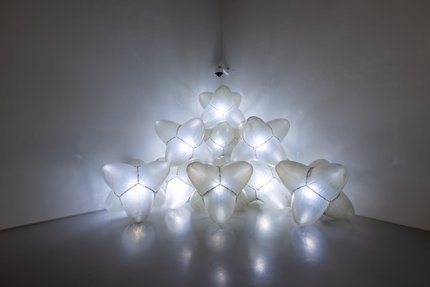Sophia Al-Maria: INVISIBLE LABORS daydream therapy is an exhibition that centres dreaming as a methodology to engage with personal and contested histories of labor and creativity and how that relationship to expendable labor and free time has translated into the contemporary moment in the Gulf. Foregrounding the importance of storytelling and speculative narratives as strategies for survival, imagination and reclaiming futures, it is an invitation to visitors to wonder how dreams can become society’s oxygen to sustain us beyond these times of duress.
Can a dream become a catalyst to see beyond our immediate ordeals? What is the power of dreams? Where’s the space for self-realization?
These questions and many others swerve through the exhibition. Reverberating, the slash title of the exhibition is an explicit reference to dialogue between this project and American filmmaker Bernard Nicolas’ short film Daydream Therapy (1977), which showcases how global inequalities shape the contours of our labor histories and dreams.
Together with collaborators old and new (photographer Aparna Jayakumar, sound artist Joe Namy, musician Kelsey Lu and many other contributors named in the work entitled Credits), Sophia Al-Maria converts the exhibition space into a site for complex, poetic, imagined and true stories — bridging the present, past and future tense of Doha, Qatar, a city with many historical and geopolitical chapters of labor migrations that continuously alter its future and past.
This show marks a return for Sophia, a former employee of the museum who, at the time, dreamt of being an artist but did not have the language or means to do so. By centralising stories of people who also cannot consider themselves artists, storytellers, poets or dreamers, daydream therapy becomes a shout-out that reverberates through those who do the work of dreaming. Despite everything, Sophia also hopes to help envision better, more equitable futures for everyone involved through a practice of speaking-into-being. It is here where the exhibition takes on the humble and yet important role of caretaker of dreams and daydreamers. After all, when we ask how a dream can be a catalyst for rekindling radical forms of solidarity across differences, we must go beyond clichés of solidarity and decentralise our privileges and (dis)comfort.

